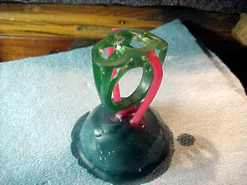


Learn the difference between the quality and care that goes into creating a custom-designed, one of a kind piece of jewelry, and "production grade" or "mass-produced" jewelry.
We will briefly follow the progress of THREE separate pieces of jewelry here, two rings and a pair of earrings, giving just the basics:
First, a sketch is made, translating the client's mental
image into a physical image. Multiple design options may be shown.




Next, a talented jewelry sculptor will take a square block
of carving wax, and turn the sketch which has been selected into a lifesize
duplicate
of the desired item. The hand carved wax will have to be perfect in every respect,
which is easier said than done.
We're looking here at beginning waxes for two different rings, one, with a single
large diamond will be in white gold,
a second ring, with three large diamonds will be done in Platinum, and lastly,
a pair of earrings which will also be done in white gold.










Below is one of the rings in progress:
Wax carving is now "Sprued Up" wax vents shown in red help deliver the platinum
to the ring. A metal cylinder is added and sealed with wax to prevent the investment
mixture from leaking out. Paper cylinder is added for overflow of investment.





If the same design is to be used more than once (two earrings
which must exactly match, for example) an exact mold of the first will be made
from molten silver.




Some items of fine jewelry will be made of Gold, other items will be made of
Platinum.
Below is the amount of Platinum necessary to create a simple engagement and
wedding ring for a new bride.
There's almost $4000. worth of Platinum in this tiny little plastic bag.

Platinum (depending upon alloy used) is typically heated to 3224 degrees Farenheit,
making it a far more complex metal to work with.
Gold is heated to 1550 degrees.

Below is work underway on a pair of earrings




All Melee' (small diamonds) must be carefully measured before
Pave' setting (pave' means multiple diamonds set side by side so that the entire
surface appears to be covered with diamonds) . A lot of measuring and precise
layout work has occurred. Precision is a must, there are NO MISTAKES ALLOWED
A layout is gently scribed on the work area. Pilot holes are drilled for each
diamond. "Seats" are drilled, (this is what the diamond sits on in the setting).



Shown below left, the Setting Burr, along with seats for
diamonds drilled to perfect height. Engravers are used to cut the setting Shown
a knife engraver, this one starts the cuts. Next will be a flat engraver to
"Bright Cut" the setting. Center diamond shows set accent diamonds, side diamond
is now ready for accent diamonds to be set.



This designer likes to use a 90 degree "V" engraver for the
corners. He raises a burr in all four corners. Now the "Burrs" are sharp so
he uses a Beading tool to make a little "Bead" out of the Burr The tip on the
beading tool is convex


 |
Yes, here are even more pilot holes with seats. A lot more diamonds to go. All the holes add up. The integrity of the ring must be carefully planned to allow for the quantity of stones to be set. A careful balance of stability must be maintained. The structural integrity of the metal must not be compromised. This was carefully thought out while designing the ring. Much of the mass-produced micro-pave' work that we
see coming out of China and India today, have very small pave' set diamonds
which are set on top of the mounting without first drilling a seat. Although
the look is attractive, there is a serious problem. First, since the diamonds
are not properly secured, they often begin to dislodge within a matter
of weeks of everyday wear. Secondly, since no seat has been drilled, there
is no cleaning port for the reverse side of the diamond. Hand lotion or
other contaminants can become lodged under the stones. Why is this important?
Because when a repair needs to be made (resizing, re-tipping, or even
replacing a missing stone), if the diamonds are not totally clean on all
sides, the heat of a jewelers torch can inadvertantly destroy your diamonds.
Many jewelers don't want to waste several days working with acid just
to try to clean those diamonds before they can even work on your ring
(never a sure thing, anyway), and may simply decline to do repair work
on mass-produced micro-pave' diamond rings for this very reason. Others,
when selling this type of ring will add a disclosure, saying the ring
is not intended for daily wear, a disconcerting warning, particularly
when speaking of a wedding set. |
And here are the three final results:



BACK to TreasureCoastJewelers.com